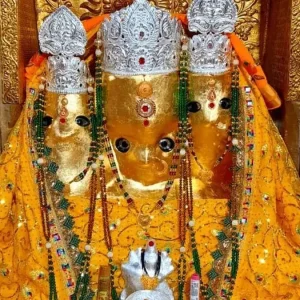
Baidyanath Jyotirlinga is one of the twelve Jyotirlingas, the holiest abodes of Shiva. It is located in Deoghar, Jharkhand, India. The temple is one of the most important pilgrimage sites in India.
The temple complex comprises the central shrine of Baba Baidyanath along with 21 additional temples. The main temple is a three-storied structure with a shikhara (tower) that is 72 feet (22 m) high. The sanctum sanctorum houses the Jyotirlinga, which is a self-manifested lingam of Shiva.
The temple is said to have been built by the Gupta dynasty in the 5th century AD. It was later renovated by the Palas, the Senas, and the Mughals. The temple complex is also home to a number of other important temples, including the Parvati Temple, the Nandi Temple, and the Ganesha Temple.
Where is the Baidyanath Jyotirlinga located?
This temple is located in Deoghar, Jharkhand. Deoghar means ‘home of Gods’.
History of Baidyanath Jyotirlinga
Baidyanath Dham has been famous since the rule of the last Gupta emperor, Adityasena Gupta in the 8th century AD. Mughal emperor Akbar’s brother-in-law built a pond at Deoghar known as Mansarovar. This temple appears to have maintained its importance even during the Muslim rule in India.
Special features of Baidyanath Temple
Along with the main temple of Baba Baidyanath, there are also 21 other temples. Some of the shrines you will find here are for Parvati, Ganesha, Brahma, Kalabhairav, Hanuman, Saraswati, Surya, Ram-Lakshman-Janaki, Ganga, Kali, Annapurna, and Lakshmi-Narayan. The Maa Parvati temple is tied to the Shiva temple with red sacred threads.
The main temple has a pyramidal tower with three gold vessels set compactly. These were gifted by the Maharaja of Giddhaur, Raja Puran Singh. There are also five knives in a trident shape (Punchsula) as well as a lotus jewel with eight petals called Chandrakanta Mani.
There is a huge Nandi, Lord Shiva’s mount, in front of the Lord.
What is the story behind Baidyanath Jyotirlinga?
It is said that demon king Ravana prayed to Lord Shiva seeking boons that would make him omnipotent. As a sacrifice, he offered each of his ten heads one after another. This pleased Lord Shiva, who came down to earth and cured the injured Ravana. The act of curing made Lord Shiva equivalent to a doctor or vaidhya/baidhya. Hence, the name Baidyanath.
Another version says that Ravana, one of the greatest devotees of Lord Shiva, requested him to make Lanka his home. The Lord could not acquiesce to that but said that the Shiva Linga would be as good as his presence. He placed the condition that while transporting the linga, Ravana must not put it down anywhere. If he did, the place where he put it down would be the site of the linga. As Ravana was transporting it to Lanka, the gods feared the consequences of the linga at Ravana’s kingdom and requested Lord Varuna, lord of the waters, to break his journey. Varuna entered Ravana’s stomach, making the demon king want to relieve himself. He descended to the ground and handed the linga to a Brahmin (Lord Vishnu in disguise) and asked him to hold it.
As soon as Ravana went to relieve himself, Lord Vishnu placed the linga on the ground and disappeared. When Ravana returned, he realized that he had been tricked. The linga was fixed to the ground. He tried with all his might to displace it. However, he could not. So, he paid obeisance to it right there. This spot is believed to be Deoghar.
This temple doubles as a Shakti Peetha as well. When Lord Shiva’s first consort, Sati immolated herself after her father Daksha’s yagna (sacrifice or offering), the grief-stricken Lord, roamed the world with her body. Lord Vishnu cut it up into 52 parts. It is said that her heart fell at Deoghar – making it a Shakti Peetha.
Interesting facts about Baidyanath Jyotirlinga
Baidyanath Jyotirlinga is also known as Baidyanath Dham locally.
Given how old the jyotirlingas and associated temples are, there is some variation in beliefs about their locations. Three different sites claim to house the real jyotirlinga – Baidyanath temple at Deoghar, Jharkhand, and Vaijnath temple at Parli, Maharashtra and Bajinath temple in Bajinath, Himachal Pradesh.
Devotees are allowed to do abhishek (anoint the linga with water) themselves on the jyotirlinga.
Shravan Mela takes place here every July-August.
While you can visit this spiritual spot at any time in the year, it would be best to visit it during the winter months – between October and March. Visiting this ancient and divine destination during Mahashivratri would be the ultimate treat for any devotee!
Kali Jayanti Puja Benefits
Puja on kali jayanti fulfills all the aspirations of individual. Goddess confers contented state of being happy and healthy and prosperous, stability, triumph, fame and ruin enemies of the devotees who contribute in this puja.
We request you to provide us the following details for the Puja
- Complete name of the person for whom the Puja has to be performed.
- Father’s Name.
- Date of Birth
- Place of Birth
- Time of Birth.
- Additional Information
- Contact Number.
Click to fill Inquiry form
*Any pooja’s and rituals done on these auspicious occasions plays prime importance to seek blessings and good fortune for all family members. Nine planets are worshiped to achieve success and the maximum power is generated from a particular planet to get it fully energized. Special Tantrik Puja’s which is performed only at midnight are done to remove ego and negativeness that hamper spiritual and material growth. Tantrik rituals are performed essentially for general happiness, health, wealth, and peace. People are blessed with intense joy, prosperity and seek protection against evil, enemies and adversities.
All the above poojas are done by tantra sadhaks by maintaining pure sanctity and incorporating vedic/tantrik rituals to get fast results.
Only your trust, faith and belief gives the best results





